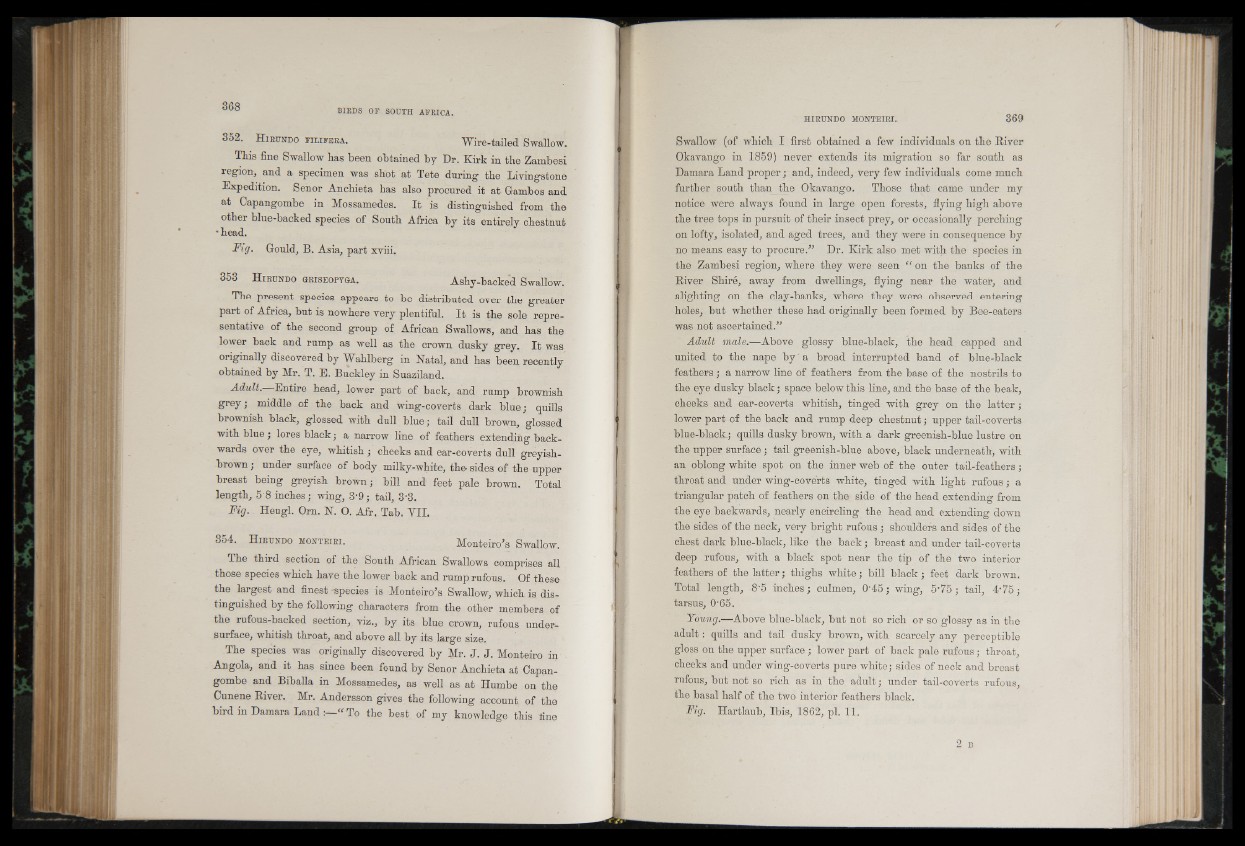
352. H iru nd o f il if e r a . Wire-tailed Swallow.
This fine Swallow has been obtained by Dr. Kirk in the Zambesi
region, and a specimen was shot at Tete during the Livingstone
Expedition. Senor Anchieta has also procured it at Gambos and
at Capangombe in Mossamedes. It is distinguished from the
other blue-backed species of South Africa by its entirely chestnut
•head.
Fig. Gould, B. Asia, part xviii.
353 H iru n d o griseopyga. Ashy-backed Swallow.
The present species appears to be distributed over the greater
part of Africa, but is nowhere very plentiful. I t is the sole representative
of the second group of African Swallows, and has the
lower back and rump as well as the crown dusky grey. I t was
originally discovered by Wahlberg in Natal, and has been recently
obtained by Mr. T. E. Buckley in Suaziland.
Adult. Entire head, lower part of back, and rump brownish
grey ; middle of the back and wing-coverts dark blue ; quills
brownish black, glossed with dull blue; tad dull brown, glossed
with blue ; lores black; a narrow line of feathers extending backwards
over the eye, whitish ; cheeks and ear-coverts dull greyish-
brown ; under surface of body milky-white, the sides of the upper
breast being greyish brown j bill and feet pale brown. Total
length, 5 8 inches; wing, 3 9 j tail, 3‘3.
Fig. Heugl. Om. N. 0. Air. Tab. VII.
354. H iru nd o m o n t e ir i. Monteiro’s Swallow.
The third section of the South African Swallows comprises all
those species which have the lower back and rump rufous. Of these
the largest and finest -species is Monteiro’s Swallow, which is distinguished
by the following characters from the other members of
the rufous-backed section, viz., by its blue crown, rufous undersurface,
whitish throat, and above all by its large size.
The species was originally discovered by Mr. J. J. Monteiro in
Angola, and it has since been found by Senor Anchieta at Capangombe
and Biballa in Mossamedes, as well as at Humbe on the
Cunene River. Mr. Andersson gives the following account of the
bird in Damara Land " To the best of my knowledge this fine
h ir u n d o m o n t e ir i. 3 6 9
Swallow (of which I first obtained a few individuals on the River
Okavango in 1859) never extends its migration so far south as
Damara Land proper; and, indeed, very few individuals come much
further south than the Okavango. Those that came under my
notice were always found in large open forests, flying high above
the tree tops in pursuit of their insect prey, or occasionally perching
on lofty, isolated, and aged trees, and they were in consequence by
no means easy to procure.” Dr. Kirk also met with the species in
the Zambesi region, where they were seen “ on the banks of the
River Shire, away from dwellings, flying near the water, and
alighting on the clay-banks, where they were observed entering
holes, but whether these had originally been formed by Bee-eaters
was not ascertained/'
Adult male.—Above glossy blue-black, the head capped and
united to the nape by '' a broad interrupted band of blue-black
feathers ; a narrow line of feathers from the base of the nostrils to
the eye dusky black; space below this line, and the base of the beak,
cheeks and ear-coverts whitish, tinged with grey on the latter;
lower part of the back and rump deep chestnut; upper tail-coverts
blue-black.; quills dusky brown, with a dark greenish-blue lustre on
the upper surface; tail greenish-blue above, black underneath, with
an oblong white spot on the inner web of the outer tail-feathers ;
throat and under wing-coverts white, tinged with light rufous; a
triangular patch of feathers on the side of the head extending from
the eye backwards, nearly encircling the head and extending down
the sides of the neck, very bright rufous ; shoulders and sides of the
chest dark blue-black, like the back; breast and under tail-coverts
deep rufous, with a black spot near the tip of the two interior
feathers of the latter; thighs white; bill black; feet dark brown.
Total length, 8'5 inches; culmen, 0-45; wing, 5-75; tail, 4'75;
tarsus, 0-65.
Young.—Above blue-black, but not so rich or so glossy as in the
adult: quills and tail dusky brown, with scarcely any perceptible
gloss on the upper surface ; lower part of back pale rufous; throat,
cheeks and under wing-coverts pure white; sides of neck and breast
rufous, but not so rich as in the adult; under tail-coverts rufous
the basal half of the two interior feathers black.
Fig. Hartlaub, Ibis, 1862, pi. 11.
2 B